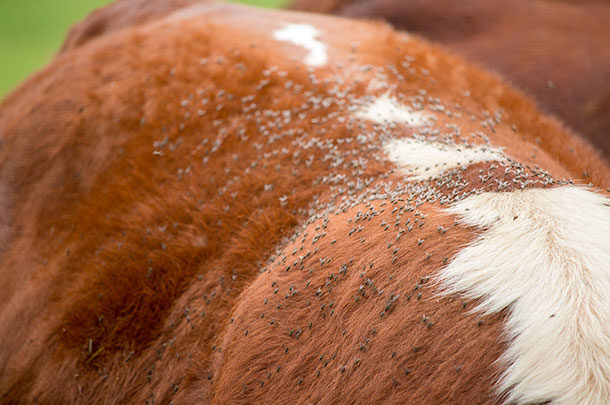“This would be one of the fields that we really don’t have what you would call ‘natural,’” Swiger says. Swiger mainly blames this on the insect itself, but some of the blame falls on the industry as well.
“Livestock entomology is not a heavily invested field,” Swiger says. “Most of our chemicals usually come from somewhere else, and a lot of natural-based products just don’t have a long residual.” Swiger says many self-proclaimed natural products only work for 24 to 48 hours. “In the eyes of a product where you need to treat cattle, having to treat them every two to four days is not a sufficient option,” Swiger says.
Swiger mentions that many products claiming to be natural or organic don’t actually have the facts to back it up in regard to animal and product safety. “Just because it says it’s organic or natural does not mean it’s safe – we have a lot of ‘natural’ products that are actually very unsafe.”
Although natural products are limited, there are various other viable options. But to understand fly control, we must first understand the pests we are dealing with.
The number one pest in regard to biting flies in cattle is the horned fly. The horned flies surpass all other flies. They live their lives on the hides of cattle and lay eggs in cattle manure.
Two other big players in the cattle fly game are stable flies and horse flies. Stable flies bite on the ankles and are bigger in dairy cows or beef cattle, but are still well-known around the pasture. Horse flies, although less common than the horned fly, take a slightly different, more dangerous approach to attacking cattle. “They don’t have the ability to suck the blood up; they have to cut these big holes, and then they feed off the blood, so it’s very unpleasant for the animal,” says Swiger.
Now that we have the background on specific flies we’re attempting to manage, we can begin to decide our best method of control. The most common products in fly control are eartags, pour-ons, back rubbers, sprays and insect growth regulators (IGRs), most commonly known as feed-throughs.
Feed-throughs are the only control method that could be considered natural, due to the chemical makeup of the product. Swiger says feed-throughs are designed to synthetically mimic fly hormones.
“They [feed-throughs] mimic fly hormones, which basically causes the flies to not develop properly, leaving them to generally stay in the larval form and never molt into adults,” Swiger says. “This is also our only products that are fly control for cattle that are considered ‘larvacides’ because they target the larval form. Everything else we utilize to target the adult stage.”
Swiger says another key factor in fly control is integrated pest management. “The more products you can combine when needed will yield you better results,” Swiger says. “When it comes to fly control, it’s not just a one-time or one-product deal. A lot of times, it takes doing multiple products at the same time to get the best control.”
Swiger continues to discuss using multiple products at the same time to yield better results. “To be integrated, you have to do multiple tactics. If you use eartags, you may need to do a late summer-early fall treatment as well because, sometimes, our fly populations can get really high, and the eartags can get overwhelmed. It’s not that they’re not working, it’s that there’s just too many flies,” Swiger says.
Overall, flies can be controlled if the right combination of treatments are used frequently. However, to answer the question of “How can I control flies in cattle naturally?” The answer is, “You can’t … yet.” As a producer, you can only be hopeful that more efficient means of fly control are on the horizon. ![]()
Mayzie Purviance is a freelancer based in College Station, Texas.
PHOTO: The more products that can be integrated in fly treatment, the more effective the control will be. Staff photo.








